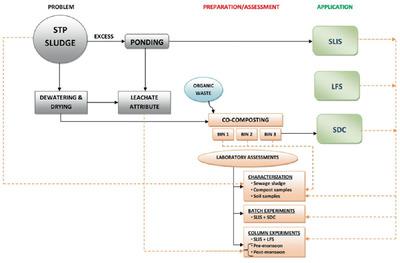当前位置:
X-MOL 学术
›
Clean - Soil Air Water
›
论文详情
Our official English website, www.x-mol.net, welcomes your
feedback! (Note: you will need to create a separate account there.)
Improving Soil Fertility and Nutrient Dynamics with Leachate Attributes from Sewage Sludge by Impoundment and Co‐Composting
Clean - Soil Air Water ( IF 1.5 ) Pub Date : 2020-10-16 , DOI: 10.1002/clen.202000125 Pandiyan Balaganesh 1 , Mangottiri Vasudevan 1 , Narayanan Natarajan 2 , Saragur M. Suneeth Kumar 3
Clean - Soil Air Water ( IF 1.5 ) Pub Date : 2020-10-16 , DOI: 10.1002/clen.202000125 Pandiyan Balaganesh 1 , Mangottiri Vasudevan 1 , Narayanan Natarajan 2 , Saragur M. Suneeth Kumar 3
Affiliation

|
Co‐composting offers a sustainable solution for community level sewage treatment plants (STP) by producing nutrient‐optimized compost. Soils in such treatment vicinity are susceptible for receiving significant quantity of wastewater, capable of causing a radical shift in soil structure and nutrient dynamics. Samples of sludge‐leachate impounded soil (SLIS) and low fertile soil are collected to select the proportioning of sludge‐derived composts (SDC). A series of batch experiments are conducted by mixing pre‐determined quantity of SDC with field soils on weight basis to identify the best proportioning combination. Based on the in‐vessel aerobic cocomposting experiments with reuse of generated leachate (at a rate of 1.0 per week), SDC exhibits good nutrient stability in terms of carbon‐nitrogen ratio (8–11) with effective moisture augmentation from leachate (45%–74%) under non‐isothermal conditions (between 46±2°C and 32±4°C) within 45 days of incubation. Significant nitrogen transformation is exhibited in SLIS samples due to the temporal variations in sludge decomposition as verified through leaching column experiments. Approximately 30% of nutrient (carbon and nitrogen) leaching is prevented due to the improved moisture retention capacity in presence of compost. An empirical correlation has been derived between various analytical measures of organic matter depicting enhanced decomposition stages of sludge in soil amendments.
中文翻译:

通过蓄积和联合堆肥利用污水污泥的渗滤液属性提高土壤肥力和养分动态
堆肥通过生产营养优化的堆肥,为社区级污水处理厂(STP)提供了可持续的解决方案。在这种处理区域附近的土壤很容易吸收大量废水,从而导致土壤结构和养分动态发生根本性变化。收集污泥渗滤液蓄积土壤(SLIS)和低肥沃土壤的样品,以选择污泥衍生堆肥(SDC)的比例。通过将预定量的SDC与田间土壤按重量混合在一起,进行了一系列的批处理实验,以确定最佳的配比组合。基于船上有氧协同堆肥实验,对产生的渗滤液进行再利用(每周1.0的速度),SDC在碳氮比(8-11)方面表现出良好的养分稳定性,在非等温条件(46±2°C和32±4°C之间)内有效地增加了渗滤液中的水分(45%-74%)孵育45天。SLIS样品中存在显着的氮转化,这是由于浸出柱实验所证实的污泥分解的时间变化所致。由于堆肥存在下提高的保水能力,可防止约30%的养分(碳和氮)浸出。在描述土壤改良剂中污泥分解阶段增强的有机物的各种分析方法之间,得出了经验相关性。SLIS样品中存在显着的氮转化,这是由于浸出柱实验所证实的污泥分解的时间变化所致。由于堆肥存在下提高的保水能力,可防止约30%的养分(碳和氮)浸出。在描述土壤改良剂中污泥分解阶段增强的有机物的各种分析方法之间,得出了经验相关性。SLIS样品中存在显着的氮转化,这是由于浸出柱实验所证实的污泥分解的时间变化所致。由于堆肥存在下提高的保水能力,可防止约30%的养分(碳和氮)浸出。在描述土壤改良剂中污泥分解阶段增强的有机物的各种分析方法之间,得出了经验相关性。
更新日期:2020-12-03
中文翻译:

通过蓄积和联合堆肥利用污水污泥的渗滤液属性提高土壤肥力和养分动态
堆肥通过生产营养优化的堆肥,为社区级污水处理厂(STP)提供了可持续的解决方案。在这种处理区域附近的土壤很容易吸收大量废水,从而导致土壤结构和养分动态发生根本性变化。收集污泥渗滤液蓄积土壤(SLIS)和低肥沃土壤的样品,以选择污泥衍生堆肥(SDC)的比例。通过将预定量的SDC与田间土壤按重量混合在一起,进行了一系列的批处理实验,以确定最佳的配比组合。基于船上有氧协同堆肥实验,对产生的渗滤液进行再利用(每周1.0的速度),SDC在碳氮比(8-11)方面表现出良好的养分稳定性,在非等温条件(46±2°C和32±4°C之间)内有效地增加了渗滤液中的水分(45%-74%)孵育45天。SLIS样品中存在显着的氮转化,这是由于浸出柱实验所证实的污泥分解的时间变化所致。由于堆肥存在下提高的保水能力,可防止约30%的养分(碳和氮)浸出。在描述土壤改良剂中污泥分解阶段增强的有机物的各种分析方法之间,得出了经验相关性。SLIS样品中存在显着的氮转化,这是由于浸出柱实验所证实的污泥分解的时间变化所致。由于堆肥存在下提高的保水能力,可防止约30%的养分(碳和氮)浸出。在描述土壤改良剂中污泥分解阶段增强的有机物的各种分析方法之间,得出了经验相关性。SLIS样品中存在显着的氮转化,这是由于浸出柱实验所证实的污泥分解的时间变化所致。由于堆肥存在下提高的保水能力,可防止约30%的养分(碳和氮)浸出。在描述土壤改良剂中污泥分解阶段增强的有机物的各种分析方法之间,得出了经验相关性。











































 京公网安备 11010802027423号
京公网安备 11010802027423号